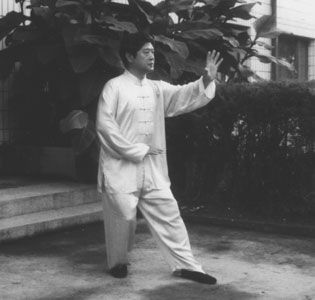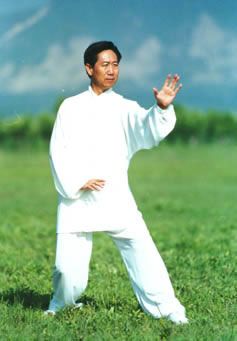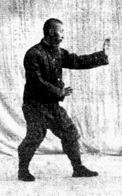Xue Sheng
All weight is underside
I have had to admit to myself that no matter how much I try I just can’t stop training Xingyiquan so I am just going to keep training what I have been taught until the right Sifu shows up.
But in the mean time I have been doing a lot of reading on Santi Shi from multiple authors; Li Tanji, Di Guoyong, Sun Lutang, Jin Yunting, Tim Cartmell and Dan Miller, Liang Shouyu, and Jiang Rongjiao and the discussion goes form the incredibly vague to the incredibly detailed and to be honest, IMO, neither is what you need to understand Santi Shi. It really is not all that complicated and not much more than stand there, shut up and relax in general but there is a bit more to it. I think the vagueness is due more to the separation of years and culture. I imagine it would be much less vague for a native Mandarin speaker that knows many of the metaphors being used but to a 21st century westerner it is a bit confusing. And to detailed is just that, to detailed and produces way too much thinking. It can get so detailed as to make you want to whip out a protractor and measure degrees of arm bend.
But I think, and here’s a surprise in you are talking CIMA, the middle way is the best way and that appears to come form the book by Tim Cartmell and Dan Miller when talking about the Xingyi of Wang Ji Wu (Shanxi Xingyiquan). There are several pages dedicated to standing practice in their book Xing Yi Nei Gong and it is well worth the read if you train any CIMA (possibly even any MA) but it all came down to the following from this book which appeared to summarize all the rest quite well.
And after reading copious songs of Xingyiquan, all I do recommend anyone learning Xingyiquan read, it all can down to what Zhang Bao Yang and Wang Ji Wu said were the most important fundamental principles to remember when practicing San Ti,
These are also found in the book Xing Yi Nei Gong but they are originally part of the Boxing Cannon
The Six Harmonies
1) the hands harmonize the feet
2) the shoulders harmonize the hips
3) the elbows harmonize the knees
4) the heart harmonizes the intent
5) the intent harmonizes with the qi
6) the qi harmonizes with the power
1 – 3 are the 3 external harmonies and 4 – 6 are the three internal harmonies
Eight Vital Points
1) the inside must be lifted
2) the three hearts must unite
3) the three intents must follow one another
4) the Five Elements must flow smoothly
5) the four terminus must move together
6) the heart must be at ease
7) the three points must be on a line
8) the eyes must focus on a single point
Also I tried the Shanxi style Santi Shi as described in the book which is a 50/50 stance as opposed to the Hebei style I have been trained that tends to be either 60/40 or 70/30 back weighted stance. I am only at best at the level of mingjen (beginner – obvious power) t best in Hebei style and all I know of Shanxi is from books and I was surprised that I found the 50/50 stance harder on my knees and it did not seem that it would be able to cover distance as much as Hebei but I am of course biased since I train Hebei and I have no training in Shanxi so I could be doing something very wrong as it applies to the posture.
And in re-reading this I do see that it still would not be clear unless you read the other books so I will post more of a description of what some of the things listed in the eight vital points and the six harmonies mean, if there is an interest, although some of them are pretty obvious,
Bottom-line is that my second Xingyi Sifu had it right when he said “if you have joint pain let me know and I will adjust your posture…. If you have muscle pain…shut up and stand… I don’t want to hear it”
Basically it is shut-up stand and relax, you can’t rush it, there is no short cut, it will hurt at first, and in time you will learn a whole lot about yourself, your body structure, how it moves as a unit not as a bunch of separate muscles and you will keep your center
Additionally -
There is also a great section in "Xing Yi Nei Gong" that discusses internal power that is very good and very much based in reality that I would recommend to anyone wanting to get to the real bits and leave much of the mysticism behind.
But in the mean time I have been doing a lot of reading on Santi Shi from multiple authors; Li Tanji, Di Guoyong, Sun Lutang, Jin Yunting, Tim Cartmell and Dan Miller, Liang Shouyu, and Jiang Rongjiao and the discussion goes form the incredibly vague to the incredibly detailed and to be honest, IMO, neither is what you need to understand Santi Shi. It really is not all that complicated and not much more than stand there, shut up and relax in general but there is a bit more to it. I think the vagueness is due more to the separation of years and culture. I imagine it would be much less vague for a native Mandarin speaker that knows many of the metaphors being used but to a 21st century westerner it is a bit confusing. And to detailed is just that, to detailed and produces way too much thinking. It can get so detailed as to make you want to whip out a protractor and measure degrees of arm bend.
But I think, and here’s a surprise in you are talking CIMA, the middle way is the best way and that appears to come form the book by Tim Cartmell and Dan Miller when talking about the Xingyi of Wang Ji Wu (Shanxi Xingyiquan). There are several pages dedicated to standing practice in their book Xing Yi Nei Gong and it is well worth the read if you train any CIMA (possibly even any MA) but it all came down to the following from this book which appeared to summarize all the rest quite well.
Our goals in practicing stance keeping are mind/body unity and a return to the natural balance
From the book
Xing Yi Nei Gong
Xing Yi Health Maintenance and
Internal Strength Development
Complied and edited by
Dan Miller and Tim Cartmell
in practicing the San Ti Shi standing posture, the student “trains to keep his or her center”
From the book
Xing Yi Nei Gong
Xing Yi Health Maintenance and
Internal Strength Development
Complied and edited by
Dan Miller and Tim Cartmell
And after reading copious songs of Xingyiquan, all I do recommend anyone learning Xingyiquan read, it all can down to what Zhang Bao Yang and Wang Ji Wu said were the most important fundamental principles to remember when practicing San Ti,
These are also found in the book Xing Yi Nei Gong but they are originally part of the Boxing Cannon
The Six Harmonies
1) the hands harmonize the feet
2) the shoulders harmonize the hips
3) the elbows harmonize the knees
4) the heart harmonizes the intent
5) the intent harmonizes with the qi
6) the qi harmonizes with the power
1 – 3 are the 3 external harmonies and 4 – 6 are the three internal harmonies
Eight Vital Points
1) the inside must be lifted
2) the three hearts must unite
3) the three intents must follow one another
4) the Five Elements must flow smoothly
5) the four terminus must move together
6) the heart must be at ease
7) the three points must be on a line
8) the eyes must focus on a single point
Also I tried the Shanxi style Santi Shi as described in the book which is a 50/50 stance as opposed to the Hebei style I have been trained that tends to be either 60/40 or 70/30 back weighted stance. I am only at best at the level of mingjen (beginner – obvious power) t best in Hebei style and all I know of Shanxi is from books and I was surprised that I found the 50/50 stance harder on my knees and it did not seem that it would be able to cover distance as much as Hebei but I am of course biased since I train Hebei and I have no training in Shanxi so I could be doing something very wrong as it applies to the posture.
And in re-reading this I do see that it still would not be clear unless you read the other books so I will post more of a description of what some of the things listed in the eight vital points and the six harmonies mean, if there is an interest, although some of them are pretty obvious,
Bottom-line is that my second Xingyi Sifu had it right when he said “if you have joint pain let me know and I will adjust your posture…. If you have muscle pain…shut up and stand… I don’t want to hear it”
Basically it is shut-up stand and relax, you can’t rush it, there is no short cut, it will hurt at first, and in time you will learn a whole lot about yourself, your body structure, how it moves as a unit not as a bunch of separate muscles and you will keep your center
Additionally -
There is also a great section in "Xing Yi Nei Gong" that discusses internal power that is very good and very much based in reality that I would recommend to anyone wanting to get to the real bits and leave much of the mysticism behind.





